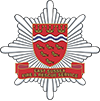
East Sussex Fire and Rescue Service | Public Sector, Emergency Services, Blue Light, Crime Prevention | ~800 staff
The Client
East Sussex Fire and Rescue Service (ESFRS) provide prevention, protection and response services within East Sussex and the City of Brighton and Hove – this extends to over eight hundred thousand people, covering both urbanised and rural locations.
These vital services aim to prevent loss of life and injury within the community, as well as help protect local buildings and the environment.
ESFRS are able to achieve this by working alongside other emergency service partners to respond efficiently to a range of emergencies, alongside delivering educational programmes, safety events, and prevention campaigns.


“Self-service was a key driver in this project for us, with risks continuously changing, and new risks regularly being discovered, it was important that any new requirements could be added to the form as and when needed.”
The Challenge
As part of the Fire and Rescue Services Act 2004, a key activity for ESFRS is to perform site familiarisation visits and exercises on premises which pose a higher risk to firefighters; these are called site-specific risk information (SSRI). Certain buildings carry a higher risk in the event of fire, these range from high-rise buildings, industrial and commercial premises, petrol stations and power stations to certain domestic properties. It is crucial firefighters and incident commanders know exactly what firefighter risks are identified and what firefighting actions are required. In addition, firefighters and incident commanders need to know which engineered solutions such as ventilation, fire alarm systems, rising mains, water supply, fire hydrants and evacuation strategies are in place and how to use them tactically to deal effectively with an incident.
ESFRS’s previous manual SSRI process meant crews assessing the risk at premises had to make handwritten notes, fill out a Word document and then send an email to their respective Station Manager for approval. This was prior to the SSRI document being uploaded manually to an SSRI system and downloaded to the services’ Mobile Data Terminals (MDT), located on each fire appliance, for use when in transit and at incidents. This process could take up to seven days to complete.
The Solution
ESFRS identified this process needed upgrading to meet aspects of the Grenfell Tower incident recommendations and to modernise the technology in use, and reached out to their ICT managed service provider and trusted partner, Telent, to help them kickstart the process.
With the support of strategic partners, Telent have been working with ESFRS since 2016 to transform key operational processes. In this instance, commercial, out-of-the-box solutions were available – but ESFRS and Telent felt that a purpose-built, configurable solution would be better placed to meet all requirements and deliver maximum impact and improve safety.
Telent introduced Tisski, a Node4 company, to ESFRS and what they had set out to achieve, and together we mapped a way forward for the organisation. The end solution would support ESFRS’s digital strategy, with a focus on alignment of digital risk data collection and current guidance, and the introduction of an auditable digital process for collecting and communicating risk data.
The Results
From 7 days to 5 minutes – a 99.9% reduction in time
As part of the project, ESFRS wanted to create a desktop-based risk assessment tool (electronic form) that would simplify and digitise the SSRI process. With Tisski on board, the process was built inside ESFRS’s Microsoft Dynamics CRM system. A companion app version of the process was also created using Microsoft Power Apps which allows crews and inspectors to go on-site with a mobile device, enter key information, amend risk information and take pictures. This would enable the information captured to be synchronised directly with the central Dynamics CRM system, prompting distribution to the MDT terminals on each fire appliance. With the information no longer sitting in limbo waiting to be uploaded manually, information is available within five minutes as it is updated for all firefighters and commanders, should they need it in the event of an emergency.
Each SSRI has an associated risk score, calculated based on all the relevant factors found at the premises. This labels a property risk to firefighters as very low, medium, high or very high risk. This level of risk allocated through the risk assessment tool does influence the level of, and frequency of, risk familiarisation activity for crews and commanders. With approval workflows built into the process, this enables monitoring of the submission of SSRI assessments; a building that retains a risk status will have its assessment automatically approved. If a risk level has increased or decreased, the SSRI assessment will be put forward for a Station Manager or Group Manager to give the final sign-off.
At the fire station, a list of SSRI visits for the day ahead synchronises to a tablet from the central Microsoft Dynamics CRM system either via Wi-Fi or mobile signal. Once on the road, if the operational member of staff finds themselves with no mobile signal, the information is contained in offline mode, meaning the information can still be completed and saved. The information is submitted and synchronised with the central CRM system once a mobile or Wi-Fi signal has been regained.
Derek Hamilton said: “The tablet app has been developed by Tisski using Microsoft Power Apps and deployed by Telent. It is particularly important to the ESFRS teams as we cover many rural areas. The information being available offline where there is no mobile signal was essential.”
Technology that really makes a difference
With the introduction of this new technology, ESFRS will benefit from improved risk analysis, reporting and enhanced risk information being immediately available to improve the safety of crews and efficient resolution of incidents.
Mark Matthews, Assistant Chief Fire Officer at East Sussex Fire and Rescue Service, said: “With Tisski and Telent’s combined technical expertise, we could see exactly what we could achieve by modernising our processes. Working in life-threatening situations daily, it’s important that we are working as quickly and efficiently as possible – Tisski has been invaluable in helping us deliver a change in technology that really makes a difference.”
Barry Zielinski, Operations and Services Director at Telent, said: “This solution clearly demonstrates the value of the long-term relationship and deep understanding we have with the team at East Sussex. We take real pride in enabling the digital transformation of these key processes, replacing paper forms to improve efficiency and ensure that the latest risk information is available within minutes.”
Project delivered by Tisski

Learn more about…


North Pole Logistics Group (NPLG)

The Most Wonderful Time of the Year… for Hackers too!
Get in touch
Contact us using the form and we’ll get back in touch shortly. Please use the telephone number below to call us, or drop us an email if you’d prefer.
GET IN TOUCH
Contact us using the form and we’ll get back in touch shortly. Please use the telephone number below to call us, or drop us an email if you’d prefer.